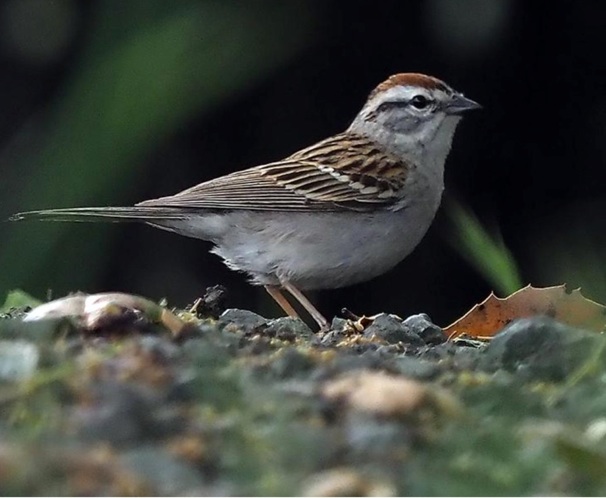A practical guide to bird watching in Sonoma County, California
(Unless otherwise indicated, all phone numbers are in the 707 area code)
A practical guide to bird watching in Sonoma County, California
(Unless otherwise indicated, all phone numbers are in the 707 area code)


Locally common from late spring through late summer. May be encountered in the county in any month of the year,
but rare December through late February. Usually arrives here in numbers in early April. Favors oak woodland and coniferous stands in the coast ranges near exposed edge areas suitable for foraging. May also be seen in parks, farmland, and even suburbia. Usually feeds on the ground, actively hopping and running. Often forms small flocks.
Chipping Sparrow is comparatively easily identified because of its clear chestnut brown crown, white “eyebrow” and the thin, dark line that extends from well behind the eye all the way to the base of the bill. Note the lack of a prominent malar stripe. Breast pale and clear. Two broken white wing bars. Streaked brown back. Grey rump lacks streaking (although young birds, which lack the strong rufous crown, may be lightly streaked at the rump). Long, notched tail. In non-breeding plumage, the rufous crown may be much reduced but the dark eyeline will always be present.
Song in the spring is an extended, evenly spaced trill that is easy to confuse with other spring trills, notably that of the Dark-eyed Junco, and may sound similar to Wilson’s Warbler trills.
Further reading:
Bolander and Parmeter, Birds of Sonoma County California, rev. ed., 2000, p. 112
Brinkley, National Wildlife Federation Field Guide to Birds of North America, 2007, p. 456
Dunn and Alderfer, eds., National Geographic Field Guide to the Birds of North America, 5th ed., 2006, p. 412
Dunn and Alderfer, eds., National Geographic Field Guide to the Birds of North America, 6th ed., 2011, p. 468
Ehrlich, Dobkin, and Wheye, The Birder's Handbook, paperback edition, 1988, p. 371, 586
Fix and Bezener, Birds of Northern California, 2000, p. 327
Floyd, Smithsonian Field Guide to the Birds of North America, 2008, p. 421
Kaufman, Field Guide to Birds of North America, 2000, p. 350
Kaufman, Advanced Birding, 1990, pp. 246-251 (notes on sparrow ID generally), p. 247, 261-266
Kaufman, Field Guide to Advanced Birding, 2011, pp. 419-433 (notes on sparrow ID generally), pp. 425, 434-439
Lukas, Bay Area Birds: From Sonoma County to Monterey Bay, 2012, p. 249-250
Parmeter and Wight, Birds of Sonoma County California, Update (2000-2010), 2012, p. 67
Peterson, Birds of Eastern and Central North America, 5th ed., 2002, p. 296-297
Peterson, Field Guide to Birds of Western North America, 4th ed., 2010, p. 332
Peterson, Western Birds, 3rd ed., 1990, p. 320-321
Sibley, Field Guide to Birds of Western North America,1st ed., 2003, p. 412
Stokes, Stokes Field Guide to the Birds of North America, 1st ed., 2010, p. 664
Vuilleumier, American Museum of Natural History, Birds of North America: Western Region, 2011, p. 400
Voice: Cornell Lab of Ornithology: All About Birds--Chipping Sparrow
© Colin Talcroft, 2009-2023
Unless noted, all photos by the author. If you would like to use one of my images, please ask for permission for non-commercial use with proper credit or commercial use with proper compensation.
Chipping Sparrow, Healdsburg, May 6, 2023
For comparison: Lincoln's Sparrow
Nagasawa Park, Santa Rosa, January 11, 2010
Note head shape and buffy grey color in particular
For camparison: Song Sparrow
Ellis Creek Water Recycling Facility, January 7, 2010
For comparison: Song Sparrow
Spring Lake, Santa Rosa, January 21, 2012
Chipping Sparrow
Spizella passerina
Sonoma County data. Graph provided by eBird (www.ebird.org), generated May 22, 2023
EBird-reported occurrence in Sonoma County

